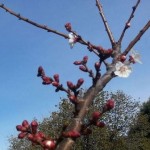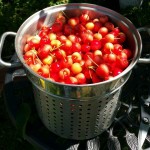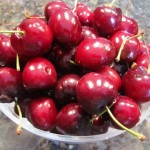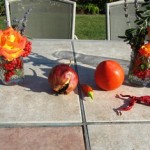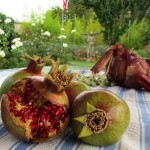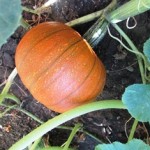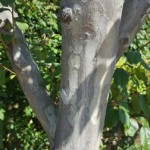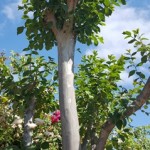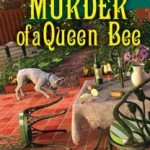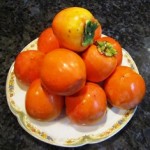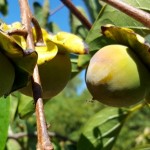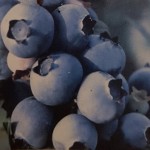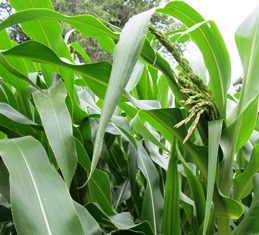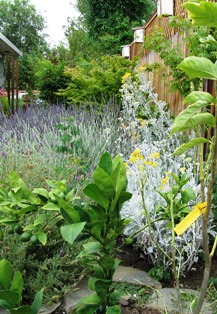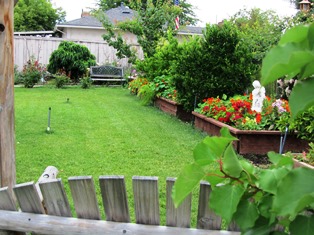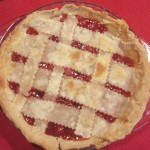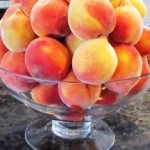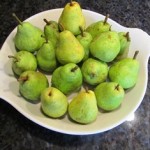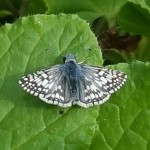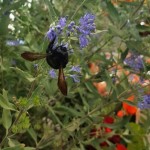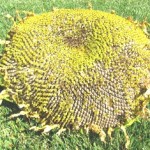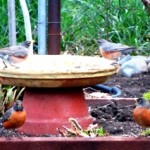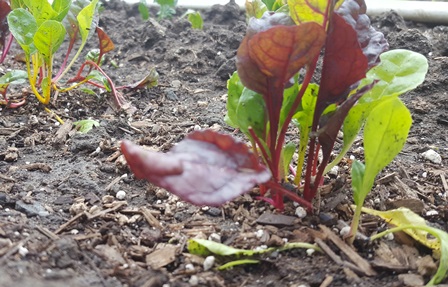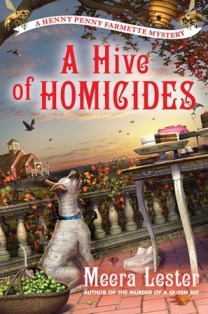Archive for the 'Plants and Trees' Category
Growing a Bountiful Crop of Sweet Cherries
Cherries are perfectly suited for growing well in our northern California climate. About ten years ago, we planted several sweet cherry trees–Bing, Stella, and Black Tartarian. They’ve proven to be easy trees to grow and reward us with bountiful crops of sweet, ripe cherries around Memorial Day each year.
If you want to grow some sweet cherries, you’ll need to space for a tree or two. Sour cherries will self pollinate but sweet cherries need a pollinator and that means you’ll need to plant two trees 30 to 40 feet apart unless you are growing a dwarf variety. Dwarf trees should be spaced 5 to 10 feet apart. The trees need sun, good air circulation, and well-drained fertile soil. Drainage is important because cherry trees are susceptible to root rot.
Once the trees are established, prune in early spring to remove large limbs or those that are broken, damaged, or too weak to produce fruit. In late summer, a second pruning can be done (this one less aggressive) to open up the canopy and improve air circulation.
A newly planted cherry tree can take three to five years to produce fruit. But you’ll be rewarded when your full-size tree produces 40 to 50 quarts of ripe fruit. In Northern California, cherries ripen from early June to late July.
You’ll be sharing your ripe cherries with the birds unless you use netting over your tree. A bird will peck a single hole in a perfect cherry and then move on, leaving the damaged cherry to rot on the tree. Local wildlife such as opossums and raccoons also enjoy feasting on cherries, climbing the trees to reach the fruit.
Cherries must be picked at the peak of perfection for if they are picked too soon, the fruit will not slowly ripen in your kitchen. Cherries are more perishable than blueberries, so wash and eat them soon after picking. A pit remover makes it easy to remove the stone from the center of the fruit.
Some people prefer sour cherries for making pies and jam and sweet cherries for eating fresh. Preserve cherries after removing the pits by canning in a hot water canner, drying them using a dehydrator, or freezing them.
______________________________________________________________________________
If you enjoy reading about our adventures in country living, check out my Henny Penny Farmette series of cozy mysteries. They’re chocked full of delicious recipes, gardening tips, and insights into keeping chickens and honeybees. Or, learn about how to take better care of yourself with my health, wellness, and spirituality books. All are available online and wherever books are sold.
Simple Gratitude for the Harvest
It’s nearly Thanksgiving and our Henny Penny Farmette continues to bring forth delicious, organically grown edibles for our table for which we feel truly grateful.
We give thanks, too, for neighbors like Dan and Annie. This past Sunday, Annie carted to our house a box of persimmons and bags of apples and pomegranates. We harvested all our apples last month so her timing was great. While we have persimmons and pomegranates hanging on the trees in our small orchard, many are not yet ripe enough to pick.
Last month, I froze cubes of butternut squash in freezer bags and readied pumpkin flesh for pie. While picking a few ripe persimmons recently, I noticed that we’re sharing them with a visitor who seems to sneak in and munch during the night. I’m thinking the culprit could be a raccoon, opossum, skunk, squirrel, fox, or a gaggle of wild turkeys that seem to make an annual pilgrimage through our area.
The two main types of persimmons grown on our farmette are Fuyu and Hachiya. The Fuyu is rather squat-looking and Hachiya has an elongated shape. Both take on a bright orange color in the fall. When fully ripe, Fuyu is sweet and crunchy like an apple whereas the Hachiya is soft like jelly. Though commonly thought of as fruits, persimmon and pomegranate are technically berries.
Fuyu persimmons can be peeled, sliced, and eaten fresh, roasted, or tossed into salads. They add a vibrant splash of orange to a winter salad that could include slices of citrus and pear tossed with greens,walnuts, pomegranate seeds, and goat cheese.
Pomegranates are ripe when their leathery outer covering turns red and begins to crack. Inside each pomegranate is white tissue separating compartments of ruby-red seeds called arils.
The seeds are high in antioxidants that reduce inflammation and free radical damage. Though they are messy to remove, the pomegranate seeds are healthy and nutritious additions to any diet.
To preserve pomegranate seeds, freeze them on a baking sheet. Once frozen, slip the seeds into freezer bags and return to the freezer. The seeds can be kept frozen for months.
Pumpkins come in a variety of sizes and types. Personally, I prefer the sugar pumpkins for recipes calling for pumpkin as an ingredient.
This week as we prepare for the big feasting day of Thanksgiving, lots of cooks are already baking pumpkin pies. Many will use canned pumpkin as a shortcut to their pie preparation but pumpkin filling made from scratch is especially delicious.
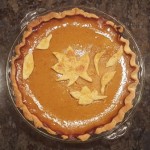
Our pumpkin pie features leaves of pie dough, brushed with egg, and sprinkled with sugar before baking
The old fashioned way to make pumpkin pie from scratch is to use fresh, organic pumpkin puree from the produce that you’ve grown in your garden. The process to make a pie takes longer because first the pumpkin must be peeled, seeded, and cut into manageable pieces and then cooked down. Then just follow your favorite pumpkin pie recipe.
_________________________________________________________________
Taking care of yourself is one of the most important things you can do over your lifetime and it starts with healthy ingredients and fresh produce.
My newest self-help wellness book is THE SELF-CARE PLANNER, A Weekly Guide to Prioritize You.
My books are available for purchase through online and traditional bookstores everywhere. Buy The Self-Care Planner and other titles offered by my publisher, Simon & Schuster online. Visit my author’s page at https://www.simonandschuster.com/authors/Meera-Lester/2137649823

It’s never too late to get healthy and live a richer, fuller, and more meaningful life. Self care is not selfish but rather an act of love.
YOU NEED THIS BOOK. WE ALL DO.
Buy it now from:
https://www.simonandschuster.com/books/The-Self-Care-Planner/Meera-Lester/9781507211649
Check out more recipes and tips for healthy country living in my Henny Penny Farmette series of cozy mysteries (Kensington Publishing, NY).
Transplanting a Decades-Old Crape Myrtle Tree
Friends said it was a bad idea. The tree was too large, too old, and too unwieldy to dig up and transport from my daughter’s property to mine. The crape myrtle would not survive, they told me, because its large root would need to be severely cut. Also, without a crane or other lifting device, three of us would be struggling to deal with such a heavy tree.
I won’t say moving the tree was easy. It had been standing for 28 years next to my daughter’s house, but she wanted to make way for new landscaping. When the family decided to part with the tree, they called on a family friend who worked as an arborist. He would do the cutting and digging of the tree.
Crape myrtles (of the genus, lagerstoemia) are available as shrubs and trees and are lovely in bloom with showy paniculate flowers in pink, fuchsia, red, or lavender. They are one of the trees that make little-to-no pollen (great for allergy sufferers). Light pruning during the growing season can produce a second bloom. Much beloved in the deep south, these trees remain stately and beautiful for up to fifty years.
My daughter’s tree arrived at the farmette in mid-October strapped onto our friend’s truck. The roots had been cut away. There were no fine root hairs or stems left–just bare wood. Ditto for the tree canopy–just a few hefty branch stubs. I wondered if our efforts would prove futile.
Hubby and I prepared a large planting hole just off from the patio. We added amendments to the clay soil and drove in stakes to keep the tree stable for a year or more until it had sufficiently developed roots. I added root hormone to the soil and watered deeply the first day and several times that week.
The winter rains came. I watched, waited, and wondered if there would ever be sprouting of any kind on the woody ends where branches had been amputated. Despite a canopy, the tree’s trunk, a beautiful, gray-green wood, afforded a kind of beauty to the austere winter garden. Before spring, I scraped a fingernail on the back of the trunk and discovered the wood was not dried out but as green and moist as a young sapling.
A spell of warm weather and the buzzing of bees in early spring drew my attention upward. Our tree had sprouted a flurry of bronze-green leaves. Pink blooms will likely appear in June or July.
I’m happy now that we went to all the trouble of bringing that tree onto the farmette for transplanting. We’ll have lovely pink blooms over the remaining summers of my life thanks to the crape myrtle tree being so long-lived.
__________________________________________________________________
If you enjoy reading about gardening and farming topics, check out my Henny Penny Farmette series of mysteries: A BEELINE TO MURDER, THE MURDER OF A QUEEN BEE, and A HIVE OF HOMICIDES (Kensington Publishing).
Each book is chocked full of tips for gardening, keeping bees and chickens, and growing heirloom fruits and vegetables. There are also plenty of delicious recipes to try. Find these books on Amazon.com, Barnes & Noble.com, Walmart.com and other online retailers or purchase at traditional bookstores everywhere.–Meera Lester
Fruit Drop with Young Hachiya Persimmon Trees
My three-year-old Hachiya persimmon tree was loaded with fruit but recently went through a huge fruit drop. Possibly the long stretch of triple-digit summer heat coupled with the tree not getting enough water may have caused this problem. Young trees are more prone to fruit drop than trees that are mature.
I find the fruit drop disconcerting because Hachiyas are my favorite persimmons. It did the same thing last year.
Each autumn, I wait with anticipation watching the fruit and checking it often until October for ripeness. This fruit is highly astringent so must be eaten ripe. The fruit texture is like jelly with a sweet and slightly spicy flavor.
Besides the fruit, what I like about this persimmon is that it becomes a showstopper in the fall with red, gold, or yellow leaves. During winter, the fruit hangs on the tree like ornamentation.
The Hachiya trees are not much bothered by pests or disease. They require at least a half day’s sun and well drained soil. These trees grow to 15 to 20 feet tall. They make great landscape trees and the fruit is a wonderful bonus.
______________________________________________________
If you enjoy reading about growing fruit trees or heirloom plants or trying delicious recipes or keeping bees and chickens and you like a mysteries, check out my Henny Penny Farmette series of cozy mysteries from Kensington Publishing in NY. They’re available online and in traditional bookstores everywhere.

A HIVE OF HOMICIDES is the newest offering in the Henny Penny Farmette series; available Sept. 26, 2017
Currently, A HIVE OF HOMICIDES is a featured title in Barnes & Noble’s September promotional BUY 3, GET 1 FREE sale.
WHAT IS THE BUY 3, GET 1 FREE OFFER?
Everyone who buys a Kensington cozy mystery from the B&N in-store display or any Kensington cozy mystery from BarnesandNoble.com between 9/5/17 – 10/5/17 and registers their purchase at http://sites.kensingtonbooks.com/kensingtoncozies/BN/ will:
— Automatically be entered into Kensington’s “Cozy Mystery Bonanza” sweepstakes for a chance to win a $300 value gift basket. One grand prize winner will be selected after the sale has concluded.
— Automatically receive a free Kensington Cozies recipe booklet plus a download code for the novel A STORY TO KILL by Lynn Cahoon after the sale has concluded.
* * *
DON’T FORGET TO ENTER THE FREE DRAWING AT GOODREADS.COM.
Win a signed copy of A Hive of Homicides along with a gorgeous reversible apron and a set of 2 chicken napkin rings. Enter before September 26 for a chance to win.
See, https://www.goodreads.com/book/show/33911114-a-hive-of-homicides?from_search=true
Growing Blueberries in the Bay Area
My Henny Penny Farmette is not far removed from ranch land populated by cows and dotted with towering oaks and pines. In the blistering heat of summer, the surrounding hills and canyons support little more than star thistle and wild grass that dries to become the perfect tinder for wildfires. Until recently, I doubted I could ever successfully grow blueberries that need the moist, acidic soils, more common to the Northeast and deep South.
However, after reading the University of California paper on growing blueberries here in the West, especially in the nearby Central Valley and also the Santa Clara Valley, I decided to try a couple of plants. See, http://ucce.ucdavis.edu/files/filelibrary/5842/25993.pdf.
I chose to grow Sharpblue (a southern highbush type of blueberry). These plants have beautiful blue-green foliage and a compact growing habit. When they reach their full height, they will stand 6-8 feet high and 4-6 feet wide. The plants are self-fertile.
This plant produces both flowers and fruit throughout most of the year; the fruit can be picked from midsummer through the fall. To my surprise, the plant bore fruit this year.
Northern lowbush blueberries grow well in northern U.S. states and in Canada where moist soil and long hours of winter chilling fulfill the plant’s growing requirements.
For best results in the Bay Area, choose highbush blueberries such as the following: Sharpblue, Sunshine Blue, Bluecrop, Blueray, Ozark Blue, Georgia Gem, Misty, Reveille, Cape Fear, and O’Neal. Plant them in acid soil that drains well and is porous.
They may also be planted in containers on patios but require plenty of water and six hours of sun. In the hottest areas, provide part sun/shade.
Blueberries taste great in pancakes, muffins, strudels, and coffee cakes. They’re delicious in jams or stirred into yogurt (my favorite). Just a single cup of this low-cal fruit is packed with Vitamin C, fiber, and antioxidants. Freeze extra berries to enjoy later.
Try making this taste-pleasing recipe posted online at WebMD.com for Blueberry Nectarine Granola Crisp. See, http://www.webmd.com/food-recipes/features/blueberries-nutritious-things-come-in-small-packages_
_______________________________________________________________
If you enjoy reading about farmette topics, gardening, and keeping chickens and honeybees, check out my series of cozy mysteries from Kensington Publishing in New York.
Click on this link: http://tinyurl.com/ya5vhhpm
Click on this link to see The MURDER OF A QUEEN BEE: Click on this link: http://tinyurl.com/yd7pz7af
Edible Landscape: Our Garden of Gentle Disorder
I’ve long been enamored of the traditional French jardin potager or ornamental, vegetable kitchen garden. The kitchen garden has its roots the medieval jardin de curé, described by garden author Jean-Paul Collaert in Kitchen Gardens of France, by Louisa James (Thames and Hudson 1999), as a “garden of lines . . . not dabs of color” as opposed to the English cottage garden and the traditional vicarage garden.
Most potagers grow the traditional four types of plants: vegetables, fruit, flowers, and herbs. What I love is the revival of interest worldwide in heirloom fruits and vegetables, which are perfectly suited for a kitchen garden. On my farmette, I grow plants almost exclusively from heirloom seed.
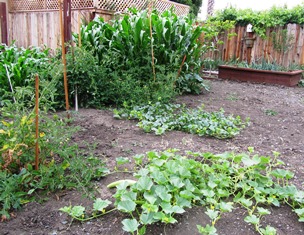
Corn, cucumber, and tomatoes share ground space; onions, garden peas, and eggplants thrive in boxes, table grapes spill over the fence
The medieval jardin de curé has been characterized by scholars as having plants in distinct beds laid out along formal lines (the Latin cross was popular). Gardening plots were defined by ge0metric shapes that could be quite complex (for example, the historic knot garden). Plants included herbs and flowers (many for medicinal uses), vegetables, berries, fruit trees, and ornamental trees and shrubs. This type of garden could be rustic or highly formal and could be found throughout France, from small farms and cloisters to country estates.
Our farmette garden has characteristics of the jardin potager and also the jardin de curé, although it could not be described as a true representation of either.
When we first moved to the farmette, we created and followed a master plan. The acreage follows a large rectangular-shape perimeter with our small house situated in the middle. Behind the house, a lawn is lined with gravel pathways. The pathways are dotted with boxes of herbs and flowers, mint, and berries. Between the boxes, the apricot, cherry, apple, fig, and persimmon trees are flourishing and producing bountiful crops.
In chaotic disorder, the beds of French perfume lavender and Spanish lavender that we planted have taken over one side of the property (much to the delight our honeybees), effectively erasing any lines that might have been obvious in an early layout. Interspersed with the lavender beds are iris, hydrangea, roses, lemon trees. Where the lavender turns a corner, bamboo creates a privacy screen, and then the fruit and flower-lined gravel path continues to the chicken house.
We moved dirt from the back half of the property and built a retaining wall along an L-shaped gravel path leading to a vegetable garden. Both sides of the path are lined with trees–apricot, pear, and pomegranate. On one side under a massive elm is a bed containing white geraniums and a variety of rose bushes.
We are following a plan for our own vision of a potager and, although I wish it had more of the lines of the medieval jardin de curé, our garden has the appearance of gentle disorder while being a prolific producer, in short, an edible landscape.
I love this living tableau. The appearance of the garden and grounds changes with the cycles of the seasons. Also ever-changing are the types of wildlife and songbirds frequenting the fountains and foraging on the fruits. There’s always something new to discover.
__________________________________________________________________
If you enjoy reading about farmette topics, gardening, and keeping chickens and honeybees, check out my series of cozy mysteries from Kensington Publishing in New York. Click on the link.
A HIVE OF HOMICIDES
Swimming in Fruit
Our cherry trees became so heavily laden with fruit this year I couldn’t work fast enough to make the fruit into cookies and pies and jars of jam, conserve, and chutney.
What fruit the birds and squirrels didn’t devour ended up drying on the trees and looking like ornaments. I’m heartened that at least the wildlife will have something to forage on through fall and winter.
The apricot trees did a massive drop of their fruit and seemingly all at once. I made more jam than we’ll probably eat, dried some, and gave away more than a few full buckets of cots to neighbors and friends. I also had to do a messy cleanup of fruit on the ground.
In the cycle now are the summer peaches; so, here I go again . . swimming in fruit.
Next year, I’m going to get my act together early with teams of backyard pickers who can help me remove the fruit, divide it, and distribute it. Right now, however, I’ve got peaches to pick and preserve. The summer pears and figs will be next.
I’m not complaining; I’m enthralled that all this bounty is due to the work of our industrious little honeybees. All this fruit and I haven’t even mentioned finding time to harvest honey. Yet, the bees don’t stop, so neither will I.
________________________________________________________________
If you enjoy reading about farmette topics like keeping bees and chickens, caring for an orchard, or growing heirloom herbs and vegetables, check out my mystery series from Kensington Publishing (due out September 26, 2017).
These novels feature a whodunnit for you to solve and are filled with farming facts, trivia, and delicious recipes. The novels and my other books are available in traditional and online bookstores everywhere. See, http://tinyurl.com/yb42zd2d
Plant for the Pollinators
I seldom need an occasion to put in another bed of flowers, but this is National Pollinator Week. I think a new bed is in order to attract local bees, birds, bats, and butterflies–all considered pollinators. Having these small creatures around benefits landscapes, gardens, and orchards.
The U.S. Fish and Wildlife Service has noted that over 75 percent of our plants are pollinated by birds, animals, and insects. We can help ensure these creatures will be around for a long time if we restore their habitats and ensure they have food and water.
There are many lovely plants you can grow that don’t require a lot of care.
- lavender
- bee balm
- echinacea
- sage
- cilantro
- thyme
- sunflowers
- sweet alyssum
- anemone
- borage
- geraniums
- scented pelargoniums
- mint
A tapestry of colorful herbs and flowers beautifies your landscape and pollinators love the diversity. If you don’t have a lot of space, grow some of these plants in planter boxes, clay pots, or other types of containers.
Put in a water feature, too, such as a table-top or larger fountain that recycles water. Even a pottery saucer filled each day can attract pollinators.
It won’t take long for the bees and hummingbirds to find the water. Their frequent visits are fun to watch, and they’ll likely be sipping throughout the day.
_________________________________________________________________________
If you enjoy reading about farmette topics, check out my Henny Penny Farmette series of cozy mysteries from Kensington Publishing. My newest novel includes delicious recipes, tips on keeping bees and chickens, and much more. Click on this URL for more information, http://tinyurl.com/ya5vhhpm
.
Grow Seasonal Greens Now
The cool season of spring is the optimum time to grow seasonal greens for salads and healthy blended shakes. In my kitchen garden, I’ve planted a variety of lettuces, spinach, kale, and chard. Most salad greens are easy to grow also in containers, raised beds, and window boxes when gardening space is limited.
Add compost and aged chicken manure to enrich the soil with nitrogen. Plant heirloom seeds about 1/2 inch in the soil, cover, and water. Within a week or 10 days, you should see the seedlings pop up. The greens will be ready to pick in about 25 days.
Water the plants to keep them hydrated but don’t drown the plants. When you are ready to make a salad, snip the leaves you want with kitchen scissors. New leaves will soon form if the roots are not disturbed and the plant continues to get nutrients and water.
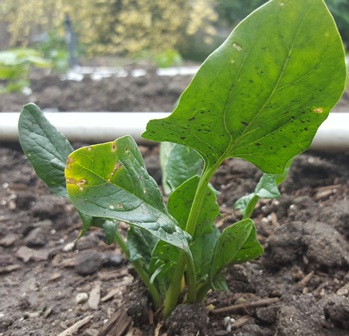
Spinach can be started in seed cell flats and then transplanted into your garden when all danger of frost has passed
SALAD OF FRESH GREENS
1. Snip a variety of greens in the early morning. Wash and thoroughly dry the leaves.
2. Place them in a bowl and crumble on some sharp cheese such as your favorite goat cheese or a Gargonzola (blue-veined, sharp tasting, and crumbly).
3. Add 1/2 cup sugared or candied walnuts.
4. Add some slice red onion and a handful of dried cranberries or chopped dried apricots.
5. Drop into the bowl some slices of a pear such as Bosc (considered the prince of pears).
6. Gently toss the salad and then spritz with red wine vinaigrette prior to plating on pretty salad serving dishes.
* * *
If you love reading about gardening and other farming topics, check out my Henny Penny Farmette series of cozy mysteries that include A BEELINE TO MURDER, THE MURDER OF A QUEEN BEE, and A HIVE OF HOMICIDES.
-
Delicious recipes
-
Farm quips and quotes
-
Tips for gardening and keeping chickens and bees
-
An exciting whodunnit mystery
How to Grow a Fruit Tree from a Pit
Nothing beats a breakfast of summer fruit picked fresh from a patio or backyard tree. I’m referring to fruit trees such as apricots, peaches, and nectarines. Cherries and plums are also among my favorites. The fruit from these trees is often referred to as stone fruit because of the hard pits (holding the seed) around which the fruit forms.
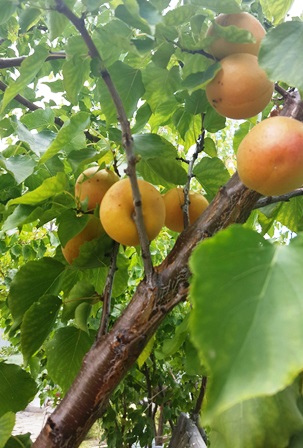
By mid-May, ripe apricots hanging on the trees in my backyard don’t last long–they’re eaten fresh, made into jams, and dried
Apricots in the Bay Area ripen in mid-May and peaches often ripen a bit later during the three months of summer (depending on the cultivar). If you love eating the fruit, don’t toss the pits. Consider that an apricot or peach grafted onto rootstock might cost upwards of $20 during bare-root season but $35 to $50 if sold in a pot. Growing from seed costs nothing.
Planting the seed extracted from the pit of your favorite apricot or peach variety can generate a tree with a very good chance of carrying the parent trees’ traits and producing fruit within three to five years. In fact, I’ve found that pits of my apricot, cherry, wild plum, peach, and nectarines that are left on the ground or discarded by the squirrels who’ve eaten the fruit will often sprout on their own.
Use this ten-step method to grow a peach or apricot tree from seed.
1. Choose a pit from a locally grown ripe fruit that tastes juicy and delicious.
2. Dry the seed on a paper towel in your kitchen window for several days.
3. Carefully crack open the hard shell of the pit to reveal the seed inside (it will resemble an almond).
4. Put the seed (or several seeds) in a sealed container in your refrigerator and let it chill for up to three months. The cool temperature exposure helps the seed get ready to sprout.
5. Time your removal of the seed from the refrigerator to a month before the last frost date in your area.
6. Cover the seed in water overnight and in the morning plant it a clear glass jar of potting soil (no lid on the jar).
7. Return the jar to the refrigerator and keep the seed moist until it has sprouted (about one month).
8. When the outside weather conditions are right (no more frost and the soil begins to warm), plant the seedling in your garden in fertile, well-drained soil.
9. Dig a basin around the planting hole for watering.
10. Mulch to keep down weeds and ensure the roots stay cool. In three years, watch for blossoms in the spring with fruit to follow.
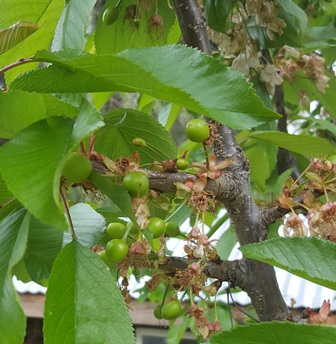
Cherry pits are much smaller than other stone fruit; pits of sour cherries (and also wild plums) may self-seed but sweet cherries less so. Cherries must have a period of cold to germinate
* * *
If you enjoy farmette topics like gardening heirloom vegetables, herbs, and fruits as well as keeping chickens and bees, check out my Henny Penny Farmette series of cozy mysteries from Kensington Publishing–A Beeline to Murder, The Murder of a Queen Bee, and A Hive of Homicides.
You’ll find in the Henny Penny Farmette series
-
Delicious recipes
-
Farm quips and quotes
-
Tips for gardening and keeping chickens and bees
-
An exciting whodunnit mystery
Also, check out MY POCKET MEDITATIONS, my newest forthcoming nonfiction title from Adams Media/Simon & Schuster, at http://tinyurl.com/l6lzorq
![My Pocket Meditations: Anytime Exercises for Peace, Clarity, and Focus by [Lester, Meera]](https://images-na.ssl-images-amazon.com/images/I/51GH%2BXEPc6L.jpg)
 Facebook
Facebook Goodreads
Goodreads LinkedIn
LinkedIn Meera Lester
Meera Lester Twitter
Twitter





